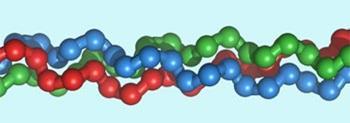US chemists have synthesised collagen fibres with dimensions similar to natural collagen, predicting the advent of 'bionic man'.
US chemists have synthesised collagen fibres with dimensions similar to the natural protein, leading the researchers to predict the advent of ’bionic man’.
Collagen is the main protein in connective tissue and is the most abundant protein in mammals. It is being investigated for medical applications, such as tissue engineering and biocompatible coatings, but research has been hindered by the fact that the main source of collagen is currently the domestic cow.

Synthetic versions of collagen, which is made of three protein strands curled round each other to form a triple helix (see above), have been developed, but only at relatively short lengths (less than 10nm, compared with around 300nm for natural collagen fibres).
Frank Kotch and Ronald Raines from the University of Wisconsin aimed to overcome this by creating short triple collagen strands with a short peptide segment sticking out the top, acting as a ’sticky-end’ to join the strands together.
The researchers found that the synthetic strands would naturally join together to form fibres as thick as natural collagen (0.5-1.0nm) and up to 400nm long. Now, they aim to combine this technique with previous work in which they created synthetic collagen fibres that were stronger than natural versions.
’In biomaterials, we envision the development of new wound-healing technologies based on our long/strong synthetic collagen,’ Raines told Chemistry World. ’In nanotechnology, we envision the creation of nanowires plated with gold or silver and decorated to act as a sensor. Perhaps nanowires based on our collagen will [also] be a step towards a mythical "bionic man".’
The findings are welcomed by William DeGrado, professor of biochemistry and biophysics at the University of Pennsylvania, US. ’This is a particularly clever piece of work,’ said DeGrado. ’[It is] noteworthy for its synthetic elegance, structural insight and potential practical application.’
Jon Evans
References
Proc. Natl. Acad. Sci. USA, (DOI: 10.1073/pnas.0508783103)






No comments yet